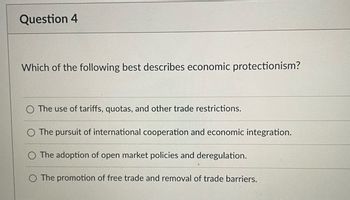Question

Transcribed Image Text:**Question 4**
**Which of the following best describes economic protectionism?**
- The use of tariffs, quotas, and other trade restrictions.
- The pursuit of international cooperation and economic integration.
- The adoption of open market policies and deregulation.
- The promotion of free trade and removal of trade barriers.
*Note: This question assesses understanding of economic protectionism, a policy aimed at limiting foreign competition to protect domestic industries.*

Transcribed Image Text:**Question 3**
*Which situations may trigger the application of the Responsibility to Protect (R2P)?*
- Violations of national sovereignty and territorial integrity.
- Political unrest, economic instability, and social inequality.
- Genocide, war crimes, ethnic cleansing, and crimes against humanity.
- Territorial disputes and conflicts over natural resources.
**Explanation of the diagram:**
The image is of a multiple-choice question commonly found in educational assessments. The question pertains to international law and human rights principles, specifically focusing on the Responsibility to Protect (R2P) doctrine. There are four options provided, each listing different scenarios that may or may not trigger the application of R2P.
This question tests the understanding of conditions under which international intervention under the R2P framework may be justified. The correct answer among the listed options is "Genocide, war crimes, ethnic cleansing, and crimes against humanity," as these are the specific situations that R2P aims to address.
Expert Solution
This question has been solved!
Explore an expertly crafted, step-by-step solution for a thorough understanding of key concepts.
Step by stepSolved in 3 steps
